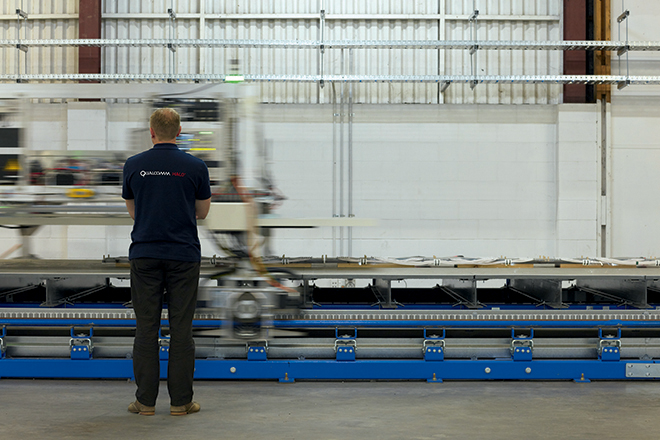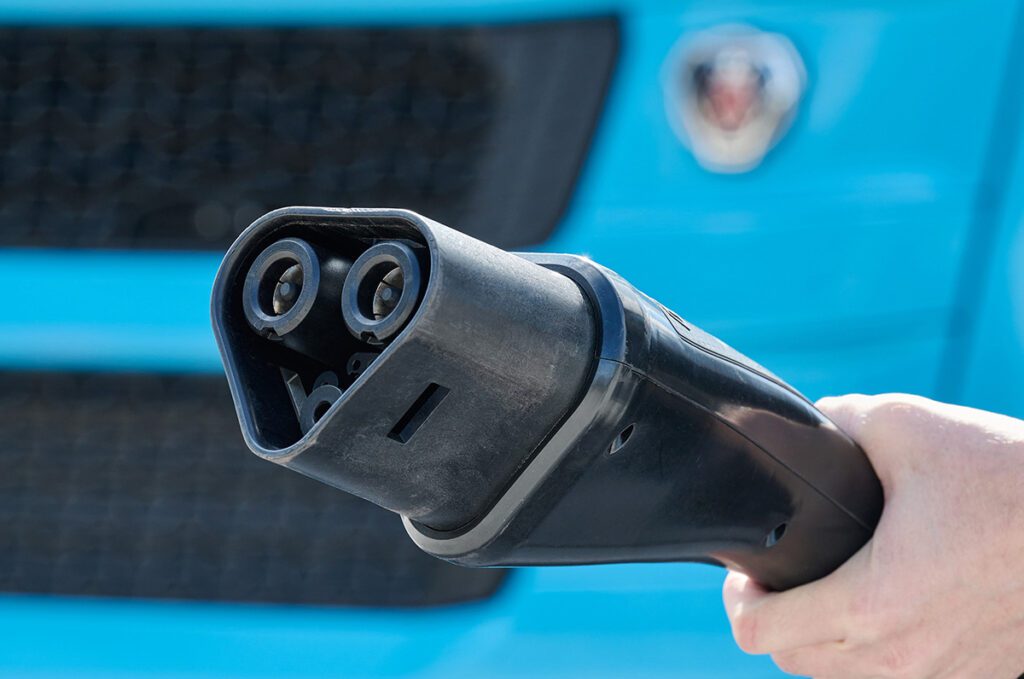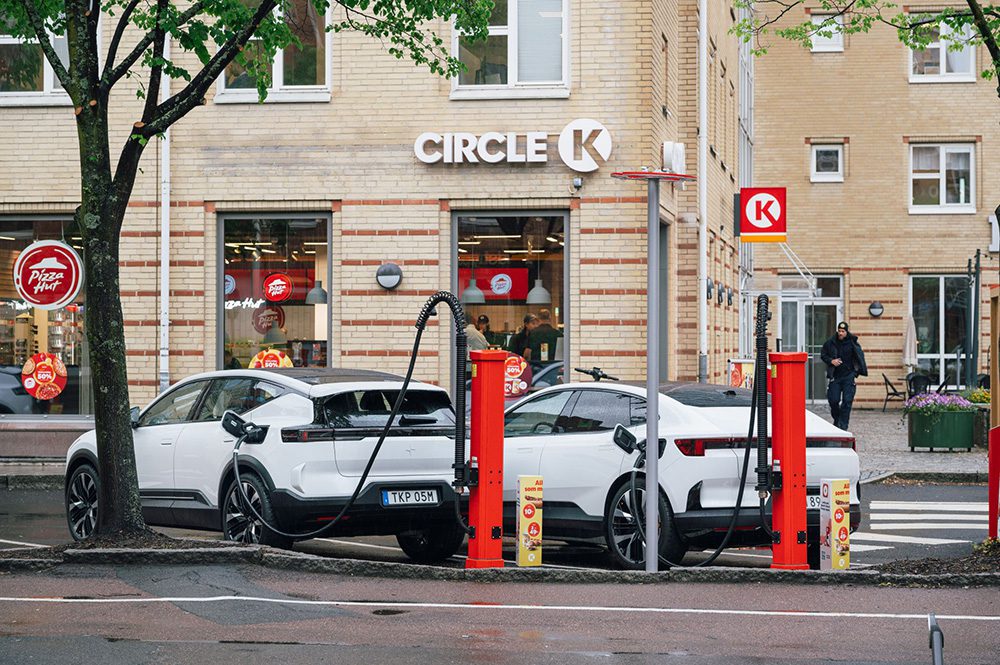Charged has been writing about Wireless Electric Vehicle Charging (WEVC) technology for several years. As far back as 2012, automakers have said they plan to include the technology on future EVs. While those plans have been delayed for a few different reasons – interoperability standards, uncertainty in the EV market, etc. – it now appears that WEVC will be available as a factory-installed option before we know it.
The new next-best-thing that EV innovators are working on is Dynamic Electric Vehicle Charging (DEVC), which allows an EV to charge wirelessly as it’s driving down the road. One of the most active players in stationary and dynamic charging is the wireless technology juggernaut Qualcomm, which recently developed and tested one of the world’s first DEVC test tracks.
The system is capable of charging an EV dynamically at up to 20 kW at highway speeds (100 km/h). Qualcomm also demonstrated simultaneous charging, in which two vehicles on the same track can charge dynamically at the same time. The vehicles were able to charge in both directions along the track, and even in reverse.
The demonstrations took place at the 100-meter test track at Satory Versailles, recently built by the French research institute VEDECOM as part of the FABRIC project. The Qualcomm Halo DEVC system was integrated into the test track, and the receiving components were installed in two Renault Kangoo EVs.

The development of the DEVC technology was supported in part by the European Commision’s FABRIC program (FeAsiBility analysis and development of on-Road chargIng solutions for future electric vehiCles).
To learn more about the future of DEVC, Charged chatted with Graeme Davison, VP of Business Development and Marketing at Qualcomm Europe, Inc.

Charged: The DEVC system you recently built and tested was a feasibility study, which indicates that we’re still in the very early days of the technology, is that correct?
Graeme Davison: That’s correct. We pushed the engineers to answer two questions: one, what velocity of vehicles could we get to; and two, what do we need to understand, going forward, about how DEVC could be implemented? A lot of the work we did was to test different situations, like the vehicle not travelling in a perfect line down the center of the track. Other scenarios we tested were the vehicle coming off charging as it changed lanes, and then coming back on to charging; the vehicle stopping whilst on the charging track, and then moving on; and even what happens if you put two vehicles on the track at the same time.
When we showed this at Versailles, we actually demonstrated all those environments that we could bring up. Vehicles swerving in and out, vehicles stopping, vehicles charging while stationary, and then two vehicles at the same time. So we have the ability to answer those questions, regarding the what-ifs of charging – what does the driver do, how does the system react, and things like that. And it was a fantastic foundational point for DEVC.

When the FABRIC program was set up by the European Commission, the overall goal was to look at EV charging technologies. And that included everything from plug-in all the way through to static wireless charging and dynamic charging, and other technologies anybody could bring to the table.
Around the same time as the FABRIC program kicked off, we’d just started a research program in New Zealand to look at dynamic charging. And then FABRIC came along and they gave us the opportunity to build this 150-meter-long track, and also to be able to push it into a much more real-world environment.
Charged: So the next step would be to explore the economic feasibility?
Graeme Davison: Yes. When we started WEVC, I remember going and speaking to the OEMs. But we also went and spoke to the infrastructure people, the power companies, city planners, car park owners and other ecosystem stakeholders. We were talking to them about the models that would be used and how people would look at both private and public static charging. And one of the questions they asked was how many EVs do we have to plan to charge? And of course, we were in exactly the same early days with the OEMs.

So we backed off from speaking to the infrastructure players, focused on the OEMs, and now we’re at the point of final testing and vehicle development for static wireless charging. So now we’re going back to the infrastructure players for static and saying to them, these EVs are coming on the road. A huge number of EVs and plug-in hybrids are going to be launched by car manufacturers over the next few years. When you take those figures to the guys that are looking at rolling out infrastructure for static charging, they’re now starting to look seriously at how they do that.
Now we’re in a similar situation with dynamic charging. We’ve proved it can be done with the technology, we’re showing the OEMs how the static charging they’re putting in evolves to this, and how it’s a fairly easy step for them. But now we’ve got a new set of people to talk to, and that’s the city planners, the traffic planners, the people that work out traffic flow patterns and how vehicles move through streets. But we’ve also engaged with a couple of universities around the world, to get them to help us understand the economics and complexities and what we need to do with the road infrastructures.
Charged: Where do you see the low-hanging fruit for dynamic technology in commercial settings?
Graeme Davison: We think the first applications will be semi-dynamic charging, in which vehicles are in a loop, and they may be starting and stopping at a regular cycle and they’re going down a particular path. One of the most interesting ones that comes to mind is that of the taxi rank. Most cities around the world have ambitious programs to move their taxi environments much more to electrification programs. The City of London, for instance, is an easy one for us to talk to – by 2020, every new London taxi sold must have a minimum capability of 65 km of emission-free travel. And if they don’t, they don’t get their taxi license. So that forces the manufacturers that provide those vehicles to really look at all options.
We’re already engaged with various folks to talk about putting semi-dynamic charging environments into the taxi ranks, where the taxis stop and go. They sit for maybe two to three minutes while someone gets in the taxi at the front of the queue, and then all the taxis move forward a little bit and then park again for a period of time. We think that’s a low-hanging fruit, and one that brings a great benefit to the city, of being able to look towards that taxi rank environment. But there are other ones out there as well, and more and more of them are coming to us as we explore this area.

Charged: You said that static charging could evolve into dynamic – does that mean you’re aiming to use the same hardware for both?
Graeme Davison: One of the key challenges we set for ourselves in the early days was that the on-vehicle components for DEVC were going to be exactly the same as the on-vehicle components for our current static WEVC systems. What we had to show people was, if they made a move now and put static charging on a vehicle, they had the future of dynamic coming as well. The technology itself, the actual pad design and the on-vehicle electronics, are the same for current static and the future dynamic.
The on-road hardware also started very similar to the stationary pads, but there was a lot more control and a lot more intelligence required. You had to know when the vehicle was over the pads, you had to power up the pads in front of the vehicle in a very quick manner, you had to de-power pads behind the vehicle so that you didn’t have pads excited when there was no vehicle over them. So there was a lot of system architecture stuff to do for the pads themselves, how the in-vehicle and on-road stuff communicate to power on and power off, and how the vehicle itself passes that information on. In the end, there was a lot of difference in the design of the dynamic track stuff versus the static.

Charged: Are there efficiency trade-offs between static and dynamic?
Graeme Davison: Yes, there is a little bit at the moment. And that’s because we’re at a very early generation of dynamic versus where we are in static. Static efficiency is north of 90 percent end-to-end, from energy put into the system to energy into the battery. For dynamic efficiency, we’re currently at about 80 to 85 percent. And there are some system trade-off compensations for that. For instance, by accepting a slightly lower efficiency, we were able to get much more tolerance on the inability to go in a straight line.
Charged: Do you envision an autonomous alignment system?
Graeme Davison: No, we expect this to be driver-operated. And in fact, the system was designed to allow the vehicle to wander back and forth across the line. There was no requirement for pinpoint driving accuracy. Most of the drivers were engineers, and we gave them the challenge of getting the maximum efficiency possible over as wide an area as possible, so that we still charged when the vehicle moved a small amount. But then if the vehicle moves a large amount, for instance in a lane change, we actually drop all the charging as the vehicle moves out of the charging lane. When the vehicle comes back into the lane, it immediately picks up charging again. So the system is able to compensate for driver inaccuracies.

Charged: When can we expect to see OEM announcements for static wireless systems offered with new EVs?
Graeme Davison: Within the next year to eighteen months, you’ll start seeing OEMs rolling out WEVC technology on vehicles. In the early days, the general way OEMs feel out customer acceptance for things that are very new is to put it on the options list. Everyone that we’re talking to is seeing that at the moment. When you’re choosing the alloy rims you want, which color you want, etc., one of the options on the tick list will be wireless charging. So you get your charging point put in the home, same as you do with plug-ins now, but instead of it being a twenty-foot cable on there, there’s a cable to a ground pad which is mounted onto the floor.
As I mentioned, we’re now pushing hard with the infrastructure and EVSE manufacturers that do commercial installations to start looking at hundreds of bays at supermarkets, cinemas and shopping malls, places where people spend a couple of hours doing something and would happily pick up a couple hours of extra charge.
I drive an EV, and one of the things I’d love is to get half of my trunk back and not have to carry so many cables around with me. We’re looking forward to the minute WEVC can be out there and purchased by people, so that they can experience the ease of use that we’ve been able to experience on the prototype vehicle that we run around Qualcomm.

This article originally appeared in Charged Issue 32 – July/August 2017 – Subscribe now.










































































































